The Worst Law Breakers on the Road
Autos, pedestrians and bicyclists all break the laws, but studies show automobile drivers do it the most.

“Bicycles Also” signs like this should not really be necessary, for a lot of reasons.
I can’t tell you how many times people complain about “cyclists” who run red lights, blow through stop signs, ride without lights at night or and don’t pay for the roads. If I had a dollar for every time someone told me that cyclists should be taught the rules of the road and given a test like motorists, I could retire and move to Copenhagen where those things actually happen.
But it surprised me to hear these tired myths brought up in response to sincere requests to level the playing field when innocent people riding bicycles or walking are killed by someone driving a car who has been proven to be negligent. It is one thing to complain about “scofflaws” and quite another to tell someone who has lost a loved one or friend that anyone walking or bicycling deserves what they get because roads are meant for cars and all “cyclists” are self-righteous, spandex wearing law breakers.
To the credit of our citizen advocate, who had the support of a Bike Fed staffer and one of our paid lobbyists in the meeting, she responded with facts and a rational argument that all road users have a right to expect people in cars to obey the laws. In fact the group did such a good job making the case for the Vulnerable Users Law that the legislator eventually apologized and said he would likely support the bill if it comes to a vote on the floor. While that’s great, and shows the importance of talking to the people we vote for about issues we care about, it also points to a genuine public relations problem bicycling has.
There seems to be an almost universal perception that as soon as someone puts a leg over a bicycle, they stop obeying traffic laws. I think this is because the laws that are easy to break and get away with on a bicycle are much more obvious. Having studied traffic safety for more than a decade, I’ve found that people break the traffic laws they can get away with, no matter what mode of travel they are using. People in cars know they can get away with driving 5-10 mph over the speed limit and that they don’t have to stop for someone trying to walk across the street in a crosswalk. People walking know they can cross against the “Don’t Walk” light at a signalized intersection if no cars are coming, and people on bicycles know they can run red lights or stop signs in similar situations.
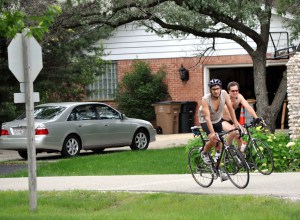
These scofflaws are actually in the minority.
When I was the Bicycle and Pedestrian Coordinator for the City of Milwaukee Dept. of Public Works, part of my job was to investigate complaints about speeding on neighborhood streets and when people said they had trouble crossing a street at a crosswalk. Before I could respond with a solution to these complaints, I needed facts so we did studies to check for speeding and to see what percentage of people failed to yield to pedestrians in crosswalks. I also did bicycle counts at intersections where I checked to see how many people obeyed the traffic signals.
So what did these studies find? Get ready for a big shock, but my studies found that in general, people riding bicycles tend to be more law-abiding than people driving cars. The percentage of people riding bicycles that made illegal maneuvers (ran red lights, rode on sidewalks, or rode against traffic) through the intersections where we did the counts varied from 11% to 48%. In short, the majority of people who ride bikes obey the law. This definitely runs counter to common perceptions.
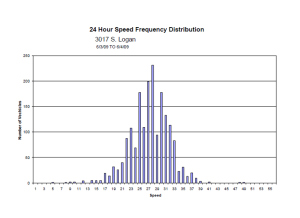
(Click to see larger image) As you can see, every car recorded to the right of 25mph is breaking the law. More cars are going above the posted limit than at or below the limit. So most people driving cars are breaking the law.
What about people driving cars? How law-abiding are they? Milwaukee DPW has done a lot of radar speed studies because so many people complain about speeders on the street where they live. The results of the speed studies vary, but in almost every case the results show a bell curve shifted to the right of the posted speed limit, as in this speed study to the left. While the results of the speed studies I did varied, they did not vary as much as the bike counts. In some speed studies, the median speed is at or just below the posted speed limit by a mile or two per hour, which means that in the best case scenario a little less than half of the people driving down our neighborhood streets are breaking the law by speeding.
The other major traffic complaint concerns failing to yield to pedestrians in a crosswalk. You may have noticed many cities have begun to put in curb extensions (“bump-outs”) and R1-6 in-street “Yield to Pedestrians: State Law” signs. You can see these bump outs and signs in Milwaukee, Madison, Wisconsin Dells and many other communities across the state. These are typical engineering responses to complaints where people say they can’t get across a street because the cars won’t stop for them when they are in the crosswalk.
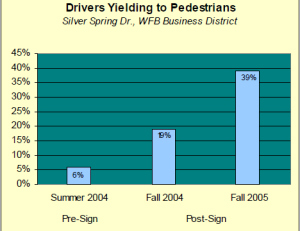
(Click to see larger image) As you can see, even after a media campaign and installation of sign in the middle of the road, 61% of motorists still broke the law and did not yield to pedestrians in a crosswalk.
There have been a couple pretty good studies done to check the effectiveness of these signs. The first study was done in Whitefish Bay by Bay Ridge Consulting. In that study, before Whitefish Bay installed the in-street yield to pedestrian signs, 94% of motorists failed to yield to pedestrians in the crosswalk. The study then checked twice after the signs were installed and a there was a media campaign to alert people about the law requiring motor vehicles to yield to pedestrians. In the final check, the yield compliance rate increased to 39%, which is a big jump, though still not very good odds if you are betting your child’s life when they walk to and from school.
The second yield compliance study was done more recently by Mark McComb. He looked at a wider variety of crosswalks, some with the in-street yield signs, some without, some crosswalks in the City of Milwaukee and some outside the city. His results were more disappointing. The best result he got was 23% of motorists yielding to pedestrians in the crosswalk at Oakland and Olive. But at two study locations, none of the cars yielded to pedestrians. So while I agree that we would all be safer if everyone (pedestrians, bicyclists and motorists) would obey all the traffic laws, it is pretty clear that people will break the laws they think they can get away with if it seems to save time. People riding bicycles are no worse than any other user of our roads. In fact, the studies suggest people who ride bikes are more law-abiding by quite a large margin than people who drive cars (and often these are the same people).
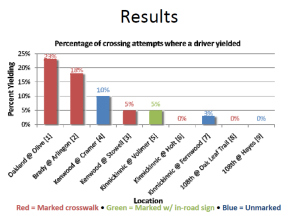
(Click to see larger image) In two of the study locations, 100% of the drivers broke the law and failed to yield to a pedestrian in the crosswalks.
So why do bicyclists have this reputation as arrogant scofflaws? Perhaps it is because the culture of driving a car is shared by the majority of adults and that speeding or ignoring people trying to cross the street is part of that shared experience. In fact, speeding is so accepted that it is called ‘driving with the flow of traffic,” and people know they can drive 5-10 mph over the posted limit right past a State Patrol car without fear of a ticket. Driving a car through a red light is still not generally accepted behavior (though it does happen quite frequently), so perhaps to a person sitting at a red light behind the wheel of a car, it seems more flagrant, or a personal insult when someone on a bike rides blows through the intersection. The problem is compounded by the fact that while most adults drive cars and share a car culture, they don’t ride bicycles for transportation. Although about half of the adults in Wisconsin ride bicycles, most only ride recreationally. Because they don’t ride to get anywhere, they don’t share the same culture of “driving a bike” where lots of people blow through stop signs because they are in a hurry to get to work, the store, etc.
I hope this column helps give you some statistical ammunition for the next time someone calls all “bicyclists” scofflaws. Even though these studies show people on bikes are generally more law-abiding than people in cars, we do have a very real public relations problem. One simple way we can all help fight the myths about bicyclists is for each of us to always obey the rules of the road when we are on our bicycles.
And when you’re driving a car, try always driving the speed limit or slower, even on the freeway. When your passengers complain that you are a slow poke, remind them of the law and that you also stop for pedestrians in crosswalk and stop for red lights when you ride a bike.
We can all hold ourselves to a higher standard. Meanwhile, all those who care about the safety of bicyclists should spread the word: bicyclists are law-abiding, red-blooded, apple pie eating Americans. We are the good guys.
This story was originally published by the Bicycle Federation of Wisconsin.
Bike Czar
-
Join a Bike Ride Under the Polish Moon
 Jun 1st, 2018 by Dave Schlabowske
Jun 1st, 2018 by Dave Schlabowske
-
9 Reasons to Join National Bike Challenge
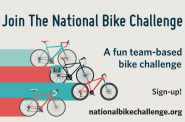 May 4th, 2018 by Dave Schlabowske
May 4th, 2018 by Dave Schlabowske
-
Biking Through the Mindoro Cut
 Apr 27th, 2018 by Dave Schlabowske
Apr 27th, 2018 by Dave Schlabowske





















IDAHO STOP: http://www.sfbike.org/?idaho
Check it out. So much common sense it hurts. Let’s lobby to make “Idaho Stop” a common term, eventually someone will listen.
Waukesha has its urban neighborhoods–mine is twenty blocks from downtown. I like to ride my bike down to a coffee shop or the library, using Summit Ave., aka highway 18. Speed limit is 30 mph, moving down to 25 mph about ten blocks from city center. What makes it particularly dangerous is the local cop shop’s seeming blindness / kindness to drivers with deep tint on both windshield and front doors.
If I can’t see / can’t make eye contact with the driver in such an illegally equipped car, I’m vulnerable. Cops do not seem to care, judging from how many (more and more each day) cars are driven in Waukesha with this dangerous and illegal equipment.
@Tyrell Yes I’d love to see the Idaho Stop brought to Wisconsin already.
Thanks for the insightful article. I wish that all Wisconsin residents could see this.
I ride a bicycle for exercise, enjoyment, and transportation. I have become more and more vigilant in traffic as I get older and have had biking friends get hit and sometimes killed by motorists on the road. Most drivers are courteous but I have had motorists honk at me and yell, not wanting to give me that right-hand lane that is the legal location for cyclists. On several occasions i was nearly hit by a motorist who failed to stop at a stop sign. It is to my (and all cyclists) best interest to obey those signs. An accident in a motor vehicle may be a fender-bender; on a bicycle it could be a life-ender.
There seems to be an error in the way this page is coded.
When you “click here for larger image” on the automobile speed graph, it doesn’t work. When you “click here” you get a page that just says “Nothing Found”.
The other two graphs work fine.
Sorry about that Tom. The original post is on the Bike Fed blog and has a working link to the speed study: http://wisconsinbikefed.org/2013/04/15/our-pr-problem-self-righteous-spandex-wearing-scofflaws/
@Tom D. I’ve corrected the link to the larger graph on Bike Czar. Thanks for letting us know about the error!
I ride in traffic a lot and my experience is that many of my fellow cyclists have a complete disregard for stop lights and stop signs. Even if a car is stopped at a stop light the cyclist goes through as if the rule doesn’t apply to them. The frustrating part to me is that simply enforces the stereotype many motorists have of us.
The odd thing is I’ve never felt in danger on the road. The two times I have crashed my bike is on the Oak Leaf which in my mind has become increasingly dangerous for cyclists because joggers and people walking their dogs have no clue how they should act on a trail and many seem to think that if I say “on your left” they should move to their left. The other issue is the increasing number of joggers who have taken to running in the roads, especially the parkways. They almost exclusively run against traffic and force a cyclist to swing out wide into the car lane to avoid them.
How about a comparison of the same violation: number of cars running a red light/stop sign v. number of bikes doing the same. Like Mike above, I think this is the one violation that motorists find most reprehensible (I know I do). Most cyclists are law-abiding, but I don’t think we help our cause by saying we’re don’t run stop signs as often as drivers exceed the speed limit. Not all violations are created equal.
OK, but let’s compare speeding instead then, since speeding is a leading cause of crashes and even small increases in speed result in much higher risk of serious injury and death. Besides, speeding kills innocent people and even in the worst case scenario, people who bicycle or walk through red lights kill the guilty person, a sort of social transportation Darwinism.
Comparison of speed: Zero to 1% of people speed when riding bicycles but 60-90% of people drive over the posted speed limit. People on bicycles seem even more law abiding comparing apples to apples.
My point is that the question should not be about what bugs people the most. Ask people sitting on their front porch, and they will say loud mufflers or speeding cars. As a people trying to cross the street on foot and they will say cars that don’t yield to them when they are in the crosswalk. Ask people when they are behind the wheel and they will say people on bikes.
We all constantly assess and balance risk or personal injury and risk of getting a ticket with what gets us from point a to b in the least amount of time with the least frustration. That balance point is different for different modes of transportation.
As for stop signs and traffic signals, compliance among people driving has been steadily dropping for decades. John Trinkaus conducted an annual stopping survey at the same intersection for nine straight years in the 1970s and ’80s, finding a creeping decline. In his 1997 study, “Stop Sign Compliance: A Final Look,” Trinkaus finds that the percentage of people making a full stop had dropped from 37 percent in 1979 to a mere 3 percent. Likewise the percentage of people who stop for yellow lights has decreased. Wisconsin 346.37(1)(b) …traffic facing a yellow signal shall stop before entering the intersection unless so close to it that a stop may not be made in safety.
I suspect that bikers as a group obey traffic laws a greater percentage of the time than drivers as a group. The trouble is that a bad experience with another driver tends to be quickly forgotten by drivers, but a bad experience with a bike sticks with you. I still remember a bad experience with a biker years ago (was turning left onto Prospect and a bike on the sidewalk going against the one-way traffic flipped me off for trying to see past the parked cars), but while I know I’ve had worse experience with cars, I don’t recall many as vividly. If I drive to work, I usually have hundreds of examples of cars generally behaving, but I usually don’t see many (if any) bikes. I just don’t think the experience of a bad biker gets lost in memory as quickly, so bikers as a whole get a negative perception.
That, or you just make drivers feel lazy and irresponsible so we resent you and look for reasons to blame all our problems on you.
Dave,
I’ve yet to see a car decide to blow through a stop sign or red light when other cars are waiting, but I see my fellow cyclists do it all the time. When cyclists do that it shows a brazen sense of entitlement that most people can’t stand. That’s just not the same as the guy who is driving 72 MPH on the freeway.
Yes, car drivers engage in all sorts of irritating behavior. At the top of the list is the guy who doesn’t believe the “left lane closed ahead” sign and decides they’ll speed up to where it closes and skip everyone in line. Cyclists also can be equally obnoxious in their behavior.
As for the speed limit. Most cyclists obey those laws because they cannot physically get their bike moving more than the posted speed limit unless they are rolling downhill in a 25 MPH zone. When I’m cruising along at 22 mph’s I’m faster than 95% of the cyclists out there and still comfortably under the speed limit. It’s not because we’re somehow more enlightened than a motorist.
Hey Mike,
In Milwaukee, bicycles make up a small percentage of traffic on the road. Because they are a visible minority, any violations they make stand out. My traffic studies have shown that people on bikes break laws (they are capable of breaking) at a lower rate than people in cars. I have not done any studies to determine who is more enlightened, nor do I make any assumptions in that regard. I am arguing that people are people and we all assess risk and opportunity in different modes of travel. I believe that on a bicycle, people see fewer opportunities to get from A to B faster that don’t entail a risk that outweighs the opportunity. That explains the more law abiding behavior, not that we are more enlightened, though I think people who rides bicycle kind of are 😉
Of course the vast majority of people on bicycles cannot physically ride over most posted speed limits. I wrote that with tongue in cheek, but to point out that one of the while most the vast majority of people see little personal risk when the opportunities are present to ignore people in crosswalks or to drive over the speed limit on city streets, those opportunity carry great external risk to innocent road users like people walking or on bicycles. As to speeding on freeways, once again we get to the hockey analogy. We all know the rules, so don’t get onto the ice if you don’t want to get checked into the boards.
I think most of us here agree with these facts:
1. people break laws more frequently when they are behind the wheel than they do when they are on foot or on bicycles.
2. The consequences people face when they break laws on bicycle or on foot carry high personal risk and low external risk.
3. Human nature is to remember the bad and forget the good, so when a visible minority breaks a law like running a stop sign, that stands out in our memories. The affect heuristic is our big PR problem that we carry with us every time we get on a bike, even if we obey all the laws.
Dave, you are being absolutely disingenuous when you compare all possible violations of motor vehicle drivers vs. those of bicyclists. As others have pointed out above, running a red light in any vehicle is far more likely to cause a serious crash then a car going 72 MPH on the freeway.
The fact is that there are some traffic laws that are virtually impossible for a bicyclist to violate, such as speeding. Why not show stats for how many bicyclists violate load or height restrictions? Gee, I guess you’d have 100% compliance with those laws, so bicyclists would be so much better than the rest of the population.
Besides, bicyclists can actually break many laws while riding that are not “traffic” laws. If a bicyclist uses a private parking lot as a cut-through (happens all the time) that is technically trespassing and not a traffic violation. When a bicyclist goes against office policy and stores their bike in the conference room or copy area during the day, that’s not a traffic violation, even though it might be a workplace safety violation.
I’m not anti-bicyclist or anti-driver. I’m anti-anyone who twists statistics to accuse the other of being sinners while refusing to acknowledge their own (and many) discretions.
I disagree and feel my statistical comparison is more than fair. First, it was not my idea to compare apples to apples, I did that at the request of a reader. Second, when we compare stop sign compliance across modes, my studies once again show people to be more compliant when on bicycles than the more famous study showed people to be when behind the wheel. Third, and most important, when people roll stop signs, run red lights (and yellows) and speed on roads that they share with more vulnerable users (people on foot and on bike), they put others at risk, not themselves. When a person walks against a Don’t Walk signal at a crosswalk, and they make a bad decision, they pay the price. When a people rides a bike through a stop signs and misjudge the cross traffic, the person on the bike pays the ultimate price.
I do agree that these are not scientific comparisons. Ideally, we would compare compliance of people on bikes, on foot and in motor vehicles at the same intersection, not compare one to another from different times. I do believe though that it is perfectly valid to draw general conclusions when comparing studies.
I stand by my statement that people are people, and they continually balance risk with opportunity to get from point A to B faster and more pleasantly. The result is we break the laws we can get away with if we don’t get hurt ourselves and it gets us to our destination faster. People in cars speed, roll stops, don’t yield to pedestrians at crosswalks and run yellow and red lights. People on foot walk against Don’t Walk signals. People on bikes roll stops, ride on the sidewalk, run reds and sometimes ride against traffic. The statistical likelihood varies with individuals and the exact traffic situation, but those are all true statements.
I’ll be the first to admit this (probably ever in history, anywhere in the world) but… when I’m driving my car, I get pissed at cyclists for breaking the rules and riding “like idiots.” Meanwhile, when I’m riding my bike, I get pissed at cars who arn’t paying attention or break the law and put me in danger.
My two main sticking points…
1. When a driver bends rules, they put others at risk. When a cyclists bends rules, they put themselves at risk.
2. What really pisses me off as both a driver and a cyclist… is the attitude of cyclists who break rules and then get angry at DRIVERS when they almost get hit while bending those rules.
I do think it would be very enlightening if every drive spent a day riding a bike on city streets. To see how their actions affect cyclists. Meanwhile, many cyclists could use some self reflection time to work on their egocentric views of traffic and attitude towards how they react when they’re breaking the laws themselves and putting themselves in danger.